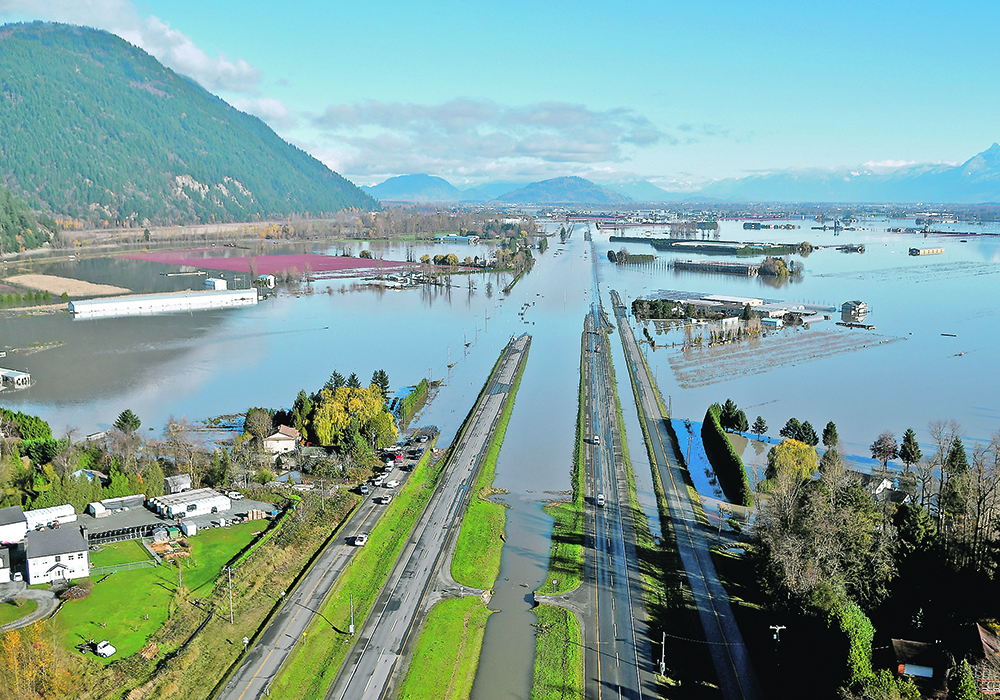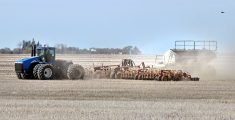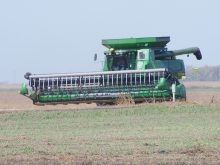Carbon taxes levied on producers should be spent helping them become more resilient to climate change, says a farm leader as he contemplates the lessons Canadian agriculture can learn from the flooding that hit British Columbia last fall.
“I think my biggest frustration with this carbon tax is the money is going into general coffers and it’s not going into climate change initiatives,” said Keith Currie, first vice-president of the Canadian Federation of Agriculture.
Comprehensive plans must be created that recognize the impact of farming on the economy and the importance of protecting food security for Canadians, ensuring the country is ready to deal with agricultural disasters sparked by climate change, he said.
Read Also

Using artificial intelligence in agriculture starts with the right data
Good data is critical as the agriculture sector increasingly adopts new AI technology to drive efficiency, sustainability and trust across all levels of the value chain.
The federal decision to implement carbon taxes is placing a disproportionate share of the burden to meet Canada’s international greenhouse gas obligations on farmers “while really not doing anything” long term to help them, said Currie.
“(Governments) don’t think about people in rural Canada that have to drive an hour or more to go buy groceries, or go to the bank, or go visit their relatives in nursing homes three hours away, or just do regular business. And we don’t have access to subways and buses and light rapid transit and public transit….”
A federal study has found the flooding that caused hundreds of millions of dollars in damage to producers in B.C. has become much more likely due to climate change. The study is still being peer reviewed, said co-author Alex Cannon, a research scientist with the Climate Research Division of Environment and Climate Change Canada in Victoria.
It estimated the atmospheric river behind the flooding is about 60 percent more likely to occur compared to the pre-industrial climate, he said. Such weather events in B.C. consist of airborne bands of water vapour originating in the Pacific Ocean that can be thousands of kilometres long.
The study found the resulting two days of intense precipitation Nov. 14-15 are now about 50 percent more likely to happen, said Cannon. It also estimated the probability of high stream flows from such events has increased by about 100 to 300 percent, he added.
The situation in November was exacerbated by wet conditions that preceded the flooding, along with factors such as snowmelt caused by rising temperatures associated with the event, said the study.
“Together these results demonstrate the substantial human influence on this compound extreme event and help motivate efforts to increase resiliency in the face of more frequent events of this kind in the future.”
B.C. was forced to declare a state of emergency Nov. 17 due to flooding and landslides that severed much of the province’s road and rail links, cutting off farmers from things such as feed and veterinary care and preventing them from getting their goods to consumers.
Although producers worked with government officials to address gaps in the food supply chain, “we got unbelievably close to disaster when it came to our food systems,” Stan Vander Waal, chair of the B.C. Agriculture Council, said during an earlier interview.
More than 1,100 farms were under evacuation order or alert due to flooding, which affected about 37,066 acres of farmland and 2.5 million livestock. Hundreds of thousands of animals ranging from poultry to dairy cows were killed.
The federal and B.C. governments announced Feb. 7 that up to $228 million will be provided to producers to help pay for extraordinary expenses from uninsurable damages. A separate program was launched only six months earlier to provide up to $20 million to B.C. producers hit by unprecedented wildfires and heat waves last summer.
Currie said after more than a quarter century of climate change conversations, it shouldn’t come as a shock that Canadian farmers and ranchers are now facing floods or droughts. Creating ad-hoc government responses that offer money to producers after such events “doesn’t really target what you need, so that’s why a bigger-picture plan needs to be in place.”
There needs to be more government research programs “that aren’t in it for profit or gain” to help prepare farmers to be more resilient to climate change, he said. It could range from investigating different kinds of agricultural, soil, or water management practices to studying genetics in plants to make them more resistant to droughts or floods.
The response to agricultural disasters as they’re occurring also needs to be strengthened, he added. “For example, how do we have a program on the shelf that we can pull off if we need to move feed from Eastern Canada to Western Canada to keep breeding stock alive so that… the entire (beef) industry isn’t devastated for two decades?”
Federal and provincial business risk management programs also need to be improved by boosting their scope and ability to respond more quickly to disasters, helping producers recover financially after extreme weather events, said Currie.
“I think it’s opening up the door for even tougher conversations that we’re having with the government on the next policy framework, and how we can build in some type of programming that are going to help our farmers or ranchers across the country, so there’s lots of things on the table.”
The current five-year, $3-billion Canadian Agricultural Partnership expires on March 31, 2023. Agricultural ministers issued a set of priorities and principles Nov. 10 at a meeting in Guelph, Ont., to guide the framework for 2023-28.
The Guelph statement includes “enhancing resiliency to anticipate, mitigate and respond to risks, including a robust suite of business risk management programs.”
Federal agriculture minister Marie-Claude Bibeau has said officials have been eyeing ways to “improve the business risk management programs and to make them responsive to the new type of challenges that we are facing.”
How much funding federal and provincial governments are willing to provide for the next five-year agreement is an open question. “Well, governments move slow … but we have to keep pushing,” said Currie.
The flooding in B.C. particularly affected the Sumas Prairie near Abbotsford, which is the site of a former lake drained in the 1920s. It contains some of the most productive farmland in Canada.
Officials had known for years that existing infrastructure, such as dikes, were insufficient to handle a major rain event, said Vander Waal. A report commissioned by the B.C. government found in 2015 the Sumas River dike was substandard and needed updating, and 74 dikes in the Lower Mainland generally did not meet provincial standards.
“Why did they sit on it?” said Vander Waal during an interview Feb. 9. “Why didn’t they deal with it then?”
He said climate change resiliency means more than asking farmers to change their practices, something he believed they were already doing on their own.
“I think we have to look at it and just say, ‘what support systems around us need to change?’”
Governments can’t simply continue to offer Band-Aid solutions to agricultural disasters caused by climate change while ignoring infrastructure, which Vander Waal said is the most important lesson to come from the flooding that hit B.C.
“I mean, think of all the money that’s going out to farmers now. Every one of those farmers would have much preferred that the government had the dikes dealt with and that they didn’t get in this flood situation.”
Vander Waal has also heard people say the flooding proves Sumas Prairie’s defences should not be strengthened and it should instead be turned back into a lake.
He said it would increase B.C.’s dependency on food from places such as California that are not only themselves dealing with drought caused by climate change, but also have a higher carbon footprint due to longer transportation distances.
He called it a backward way of thinking.
“We have to think progressively, and agriculture is good for the country … Canada needs to continue to think about how it’s going to basically do more with what we have, and that doesn’t mean that we return that land back to the Sumas Lake.”
When asked if climate change will force producers to make tough choices about where they can practise agriculture, Currie said it is important not to use the rhetoric of closing the barn door after the horses are already out.
“Our technology has advanced tremendously in the last two decades in particular, so we’re a lot better and smarter at how we do things, and we will grow the right crops in the right regions.”
Currie said his national organization has an Agricultural Policy Framework committee that is working to put together a CAP proposal for the federal government. Discussions have been held with groups across Canada ranging from the Agriculture Carbon Alliance to Farmers for Climate Solutions.
“And I’m encouraged by what we’re presenting. How the government reacts is anybody’s guess — well, I guess we’ll see when we see.”
















